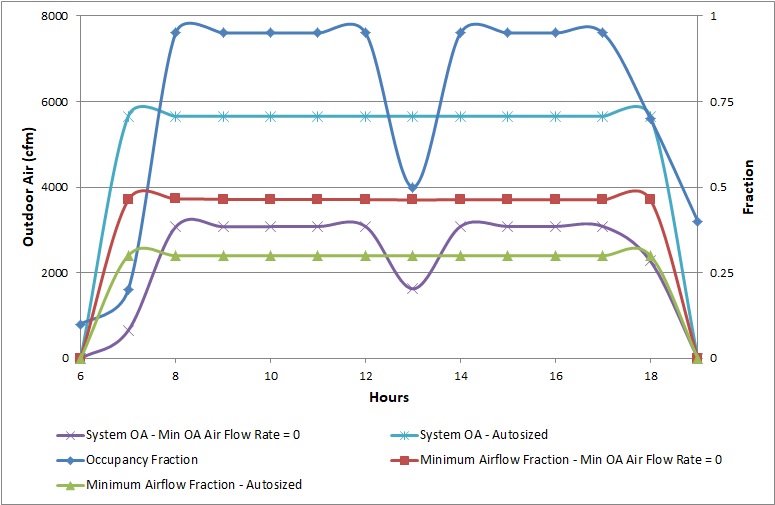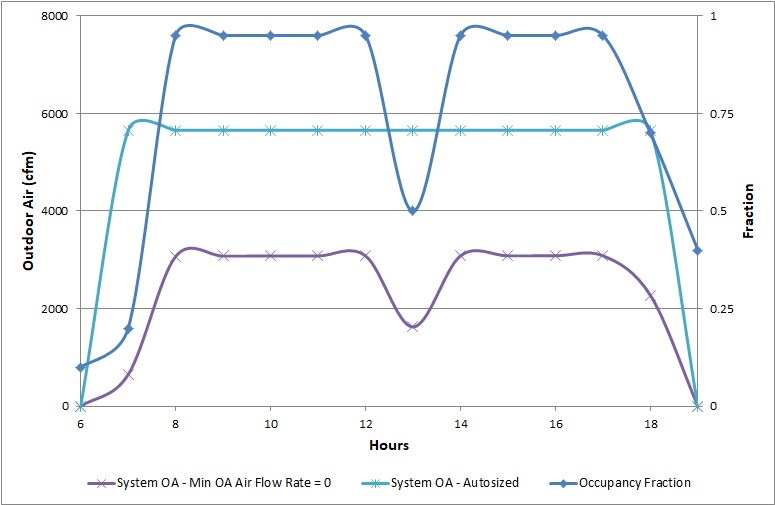OA autosized using VRP and DCV
I need to model demand control ventilation in a model where the OA is autosized using the ventilation rate procedure.
If I run the model with Demand Controlled Ventilation set to No in the Controller:MechanicalVentilation object, the OA provided by the system matches the Standard 62.1 report and matches my manual calculation.
If I run the model with Demand Controlled Ventilation set to Yes in the Controller:MechanicalVentilation object, nothing changes. The OA provided by the system is unchanged.
I came across this issue on Github. It seems to me that 2. is exactly what is going in my model. I've tried to set the Minimum Outdoor Air Flow Rate in the Controller:OutdoorAir object to 0 so the OA flow rate calculated by the VRP doesn't prevent DCV.
The results show that DCV is working but the hourly OA quantities at maximum occupancy (schedule fraction = 0.95) is about 60% of the flow calculated following the VRP, which almost equal the uncorrected OA flow rate. In this particular case I've also noticed that in heating operation the airflow fraction is greater than the minimum airflow fraction but this is not the case when the Minimum Outdoor Air Flow Rate is left to autosize.

Has anybody came across something similar?
@Molly Curtz:
- Yes, I specified VRP in the
Controller:MechanicalVentilation. - When the "Minimum Outdoor Air Flow Rate" field of the
Controller:OutdoorAir is autosized, the simulation results show a constant OA flow rate based on the VRP calcs at design conditions (curve in cyan). When the value is changed from autosize to 0, I get the curve in purple, which at full occupancy is about 60% of the cyan. - I agree with you regarding the minimum air flow fraction, I don't understand why this is happening. I am using an
AirTerminal:SingleDuct:VAV:Reheat with the "Zone Minimum Air Flow Input Method" set to “Constant” and the “Constant Minimum Air Flow Fraction” is left to autosize. The Sizing:Zone “Cooling Minimum Air Flow Fraction” and “Heating Maximum Air Flow Fraction” (I’m using DesignDayWithLimit) is set to 0.3. I’ve tried setting the “Constant Minimum Air Flow Fraction” to 0.3 and since I am using normal “Damper Heating Action” I would expect the minimum flow fraction to stay at 0.3, but it doesn’t. - The maximum supply flow rate is the same in both cases but during heating operation, the case where the minimum outdoor air is left autosize, the system flow rate is low and the outdoor air fraction is high, which makes sense to me since it’s mainly providing OA and the zone terminals handle heating. In the case where the minimum outdoor air is set to 0, the flow supplied by the system is significantly greater (and the OA fraction smaller). I’ve also noticed that in this case, one of the zone served by the system doesn’t get enough OA just like it would if "ZoneSum" was selected in the
Controller:MechanicalVentilation.
VRP. Where is the difference coming from?  ](/upfiles/15088913867925793.jpg)
](/upfiles/15088913867925793.jpg)




 ](/upfiles/15088913867925793.jpg)
](/upfiles/15088913867925793.jpg)

